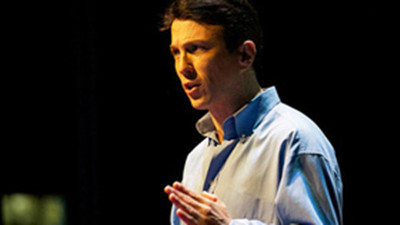And now we can see inside of the brain with a resolution and ability that was never before available,and essentially learn how to reconstruct,and maybe even re-engineer,or backwards engineer, the brain so we can better understand pathology, disease and therapy.
現在我們能看到大腦內部用一種以前沒有過的分辨率和能力,本質上學會如何重建,也許甚至再設計,或者逆向設計大腦,因此我們能更好的理解病理學,疾病,和治療。
We can look inside with real time fMRI-in the brain at real time.
我們能用fMRI即時查看內部-即時在大腦內部。
And by understanding these sorts of processes and these sorts of connections,we're going to understand the effects of medication or meditation and better personalize and make effective, for example,psychoactive drugs.
通過了解這些過程和聯系,我們能夠理解藥物治療或者冥想的影響從而更好的提供個人化有效的治療,例如,精神藥物。
The scanners for these are getting small, less expensive and more portable.
用于這些研究的掃描器變得更小,更便宜,更便攜。
And this sort of data explosion available from these is really almost becoming a challenge.
來自這種研究的數據爆炸幾乎真的成為一種挑戰。
The scan of today takes up about 800 books, or 20 gigabytes.
今天的掃描占用了大約800本書的空間,或者20GB。
The scan in a couple of years will be one terabyte, or 800,000 books.
這種掃描在幾年之內將會是1TB,或者80萬本書。
How do you leverage that information?
你怎樣利用這些信息?
Let's get personal. I won't ask who here's had a colonoscopy,but if you're over age 50, it's time for your screening colonoscopy.
讓我們從個案分析。我不會問在這里誰做過結腸鏡檢查,但是如果你年過50,是時候做結腸鏡檢查了。
How would you like to avoid the pointy end of the stick?
你怎么能避免結腸鏡的尖端呢?
Well now there's essentially a virtual colonoscopy.
現在有一種虛擬結腸鏡檢查。
Compare those two pictures, and now as a radiologist,you can essentially fly through your patient's colon and, augmenting that with artificial intelligence,identify potentially, as you see here, a lesion.
比較這兩張圖,現在作為一個放射學家,你可以瀏覽你病人的結腸用人工智能協助,確定潛在的,像你這里看到的,這是一個損傷。
Oh, we might have missed it, but using A.I. on top of radiology,we can find lesions that were missed before.
哦,我們可能漏掉它,但是在放射學上用人工智能,我們能找到以前漏掉的損傷。
And maybe this will encourage people to get colonoscopies that wouldn't have otherwise.
這也許會鼓勵人們做結腸鏡檢查以前人們反而不愿意做它。
And this is an example of this paradigm shift.
這是一個根本變化的例子。
We're moving to this integration of biomedicine, information technology,wireless and, I would say, mobile now-this era of digital medicine.
我們轉到集成了生物醫學,信息技術,無線網絡的交互應用,我想說,現在是移動電話-數字化醫學的時代。
So even my stethoscope is now digital.
因此甚至我的聽診器現在也是數字化的。
And of course, there's an app for that.
當然,它有個應用程序。
We're moving, obviously, to the era of the tricorder.
明顯我們正走向分析儀時代。
So the handheld ultrasound is basically surpassing and supplanting the stethoscope.
因此手持式超聲機基本上超越并取代了聽診器。
These are now at a price point of-what used to be 100,000 euros or a couple of hundred-thousand dollars for about 5,000 dollars, I can have the power of a very powerful diagnostic device in my hand.
目前的價位,以前是10萬歐元或者幾十萬美元,現在大約5000美元,我就能買得起一個非常強大的診斷裝置。
And merging this now with the advent of electronic medical records in the United States, we're still less than 20 percent electronic.
把這個裝置和電子醫療記錄結合起來,在美國,電子化仍然少于百分之二十。
Here in the Netherlands, I think it's more than 80 percent.
在荷蘭,我想這數據要多于百分之八十。
But now that we're switching to merging medical data,making it available electronically,we can crowd source that information,and now as a physician, I can access my patients' data from wherever I am just through my mobile device.
但是現在我們轉到合并醫療數據,使它電子化,我們能夠集中信息資源。現在作為一名醫生,我可以從任何地方查看我的病人的數據僅通過我的手機。
And now, of course, we're in the era of the iPad, even the iPad 2.
當然,如今我們處在iPad,甚至iPad2時代。
And just last month the first FDA-approved application was approved to allow radiologists to do actual reading on these sorts of devices.
上個月首個FDA應用程序證實可以讓放射專家在這些設備上直接讀圖。
So certainly, the physicians of today, including myself,are completely reliable on these devices.
可以確定的說,今天的醫生,包括我自己,完全依賴這些設備。
And as you saw just about a month ago,Watson from IBM beat the two champions in Jeopardy.
正如你們大約一個月前看到的,來自IBM的沃特森在“危險”中打敗了2位冠軍。
So I want you to imagine when in a couple of years,when we've started to apply this cloud-based information,when we really have the A.I. physician and leverage our brains to connectivity to make decisions and diagnostics at a level never done.
因此我想讓你們想像當我們在未來幾年內,當我們開始采用這種基于云端的信息,當我們真正地有了人工智能醫生來利用我們的大腦連接去做決定和診斷,在一個前所未有的技術水平上。
Already today, you don't need to go to your physician in many cases.
如今,在很多情況下你們已經不需要去看醫生。
Only for about 20 percent of actual visits do you have to lay hands on the patient.
只有大約20%情況下真的需要看醫生。
We're now in the era of virtual visits from sort of the Skype-type visits you can do with American Well,to Cisco that's developed a very complex health presence system.
我們正處在虛擬看病時代,從通過某種Skype視頻語聊式的American Well看病,到思科研制的非常復雜的健康診斷系統。
The ability to interact with your health care provider is different.
這與給你提供健康保健醫師之間的交流能力是有所不同的。
And these are being augmented even by our devices again today.
如今我們這些交流能力甚至正在被這些技術設備又增強了。
Here my friend Jessica sent me a picture of her head laceration so I can save her a trip to the emergency room-I can do some diagnostics that way.
這是我的朋友杰西卡寄給我的她頭部裂傷的照片,因此她不用來急診室-我可以通過看照片做診斷。
Or might we be able to leverage today's gaming technology,like the Microsoft Kinect,and hack that to enable diagnostics, for example,in diagnosing stroke,using simple motion detection, using hundred-dollar devices.
或者我們也許能利用今天的游戲技術,比如微軟Kinect,使其能進行診斷,比如,診斷中風,用簡單的移動檢測,用幾百元的設備。
We can actually now visit our patients robotically this is the RP7; if I'm a hematologist,visit another clinic, visit a hospital.
我們實際上現在能用機器人診斷病人,這是RP7;如果我是一個血液病專家,去另一個診所,或醫院。
These will be augmented by a whole suite of tools actually in the home now.
如果現在在家里有一整套工具,這些工具會幫助我們增強彼此的交流。
So imagine we already have wireless scales.
想像一下我們已經有了無線網絡體重計。
You can step on the scale.
你可以站在體重計上。

You can Tweet your weight to your friends, and they can keep you in line.
你可以用微博把你的體重告知朋友,他們能讓你保持身材。
We have wireless blood pressure cuffs.
我們有無線網絡血壓計。
A whole gamut of these technologies are being put together.
一整套技術正在整合在一起。
So instead of wearing these kludgy devices, we can put on a simple patch.
所以我們不用戴這些分離的裝置,我們可以把它們放在一個簡單的小片上。
This was developed by colleagues at Stanford, called the iRhythm with much more effectivity.
斯坦福的同事發明了iRhythm在價格上遠遠低于以前的技術但有效率得多。
Now we're also in the era, today, of quantified self.
現在我們處在量化自我的時代。
Consumers now can buy basically hundred-dollar devices,like this little FitBit.
人們可以買幾百元的裝置,像這個小FitBit。
I can measure my steps, my caloric outtake.
我可以計算出我的步數和熱量消耗。
I can get insight into that on a daily basis.
我能夠每天都知道了解這數據。
I can share that with my friends, with my physician.
我可以和朋友或醫生分享這些數據。
There's watches coming out that will measure your heart rate, the Zeo sleep monitors,a whole suite of tools that can enable you to leverage and have insight into your own health.
這些表可以測量心律,叫做Zeo睡眠監測儀,一整套工具能讓你受益并了解你自己的健康。
And as we start to integrate this information,we're going to know better what to do with it and how better to have insight into our own pathologies, health and wellness.
在我們開始整合信息時,我們會更好的了解用它做什么和怎么更好的了解我們自己的病理,健康和福利。
There's even mirrors today that can pick up your pulse rate.
現在有鏡子可以測量你的脈搏率。












